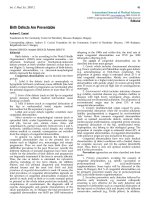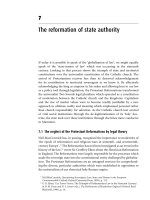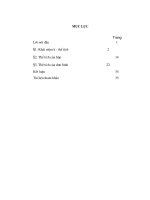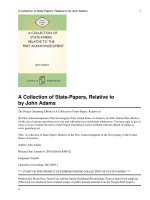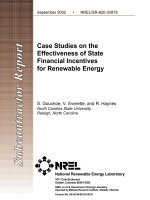wolczuk k. the moulding of ukraine. the constitutional politics of state formation. budapest, 2001
Bạn đang xem bản rút gọn của tài liệu. Xem và tải ngay bản đầy đủ của tài liệu tại đây (23.19 MB, 338 trang )
~~
THE
MOULDING
OF
UKRAINE
This Page Intentionally Left Blank
THE
MOULDING
OF
UKRAINE
The
Constitutional Politics
of
State
Formation
BY
KATARYNA
WOLCZUK
4.b
-
CEU
PRESS
4
A’
Central European University Press
0
2001
by Kataryna Wolczuk
Published
in
2001
by
Central European University Press
An
imprint
of
the
Central European University Share Company
Nador utca
11,II-1015
Budapest, IIungaiy
Tel:
+36-1-327-3138
or
327-3000
Far
+
36- 1-327-3 183
E-mail:
Website:
wv.ccupress.com
400
West
59th
Street, New
York
NY
10019,
USA
Tel:
+
1-2 12-547-6032
Fax:
+
1-212-548-4CO7
E-mail:
nigreenwald~soros1ly.org
Distri
bu
tetl
in the Unilcd Kingdom and Western Europe
by
Plymbridge Distributors Ltd., Estowr
Road,
Plymouth
PLG
7PY,
United Kingdom
Tel:
+44-1752-202301
Fas:
+441752-202333
E-mail:
orclersQplymbridge.com
in
l.lie
USA
by
CEU
Press
c/o
Books
Internatjoilal
P.O.
Box
605.
IJerndon,
VA
201
7'2,
USA
Tel:
+
1-703-661
-1
500
E-mail:
in Canada
by
CEU
Press
c/o
University
of
Toronto Press Inc.
5201
Dufferin Street. Toronto, Ontario
R13H 5T8,
Canada
Tel:
+
1-800-505-9523
&mail:
NI
right,s reserved. No part of this publication may be reproduced,
stored
in
a
retrieval system,
or
transmitted,
in
any
form
or
by
any means, without the permission
of
the Publisher.
IQX:
+
1-703-661-1501
Fax:
+
1-800-22 1-9085
ISBN
963
0242
24 5
Cloth
ISBN
963
9241
25
3
Paperback
Libraiy
of
Congress
CRt.aloging-in-Publication
Data
Wolcziik,
Kataiyia.
The
inoulrling
of
IJkraine
:
the constittitioiial politics
of
state forniation
/
by
Kataryna
Wolczuk.
Includes bibliographical
refereiicm
and
index.
p.
cm.
ISEN
063024
1248
(Cloth)
-
ISRN
963924
1253
(pbk.)
1.
Constitutional law-Ukraine.
2.
Constitutional histoiy-Ukraine.
3.
Ukraine-Politics
and
government-1901-
1.
Titlc.
KKY2070.lVG5
2001
342.477-de2
1
200
10561
70
Printed in Hungary by
Akaprint
To discover the rules of society that are best suited to nations, there would need
to
exist
a
superior intelligence, who could understand the passions
of
men
without feeling any of them, who had
no
affinity with our nature but knew it to
the full, whose happiness was independent of ours, but
who
would nevertheless
make
our
happiness his concern, who would be content to wait in the fullness
of time for
a
distant glory, and to labour in one age to enjoy the fruits in
another.
Gods
would
be needed to give men laws.
Jean-Jacques Rousseazi
(The Social
Contract,
London: Penguin Group,
1968,
p.
74)
This Page Intentionally Left Blank
TABLE
OF
CONTENTS
LIST
OF
TABLES
LIST
OF
ABBREVIATIONS
ACKNOWLEDGEMENTS
PREFACE
CHAPTER ONE
PNTR
ODUCTION: CONSTITUTIONS AND STATEHOOD
Constitutions and Constitutionalism: the Anglo-Saxon and
European Continental Perspectives
Functions
of
the Constitution
Constitution and State Formation
Plan
of
the
Book
Notes
CHAPTER TWO
IN
SEARCH
OF
A
TRADITION: DISCONTINUITIES
OF
STATEHOOD IN UKRAINE’S HISTORY
From Kyiv Rus’ to the Hetmanate
The Ukrainian Revolution
Ukraine’s National ’Awakening’ in the Nineteenth Century
The Ukrainian Revolution,
19 17-1
92
1
:
an Overview
The Ukrainian State,
19 17-1
92
1
The Political Community
The Institutional Framework
Institutions at the Centre
The
Territory
and
Territorial-
Administrative Model
The Ukrainian Soviet Socialist Republic:
19 19-1 99 1
The Institutional Framework: the System
of
Soviets
The Territorial Changes and Administrative Division
The
Political Community
Conclusion
Notes
xi
xiii
xv
xvii
1
2
7
12
17
23
29
31
33
33
36
39
39
41
41
43
45
47
50
51
52
53
viii
CHAPTER THREE
INDEPENDENCE WITHOUT A VISION: CONSTITUTION
MAKING IN 1990-1991
Ukrainian Society under the Soviet Union: an Overview
The Passage to Independence
The Limits
of
Change: Constitutional Debates and Institutional
Reforms,
1990-1 99
1
Ukraine on the Eve of Independence
The Form of Government
Socialism in Sovereign Ukraine: Ideology of the New State
Defining the ‘Sovereign People’
Conclusion
Notes
CHAPTER FOUR
SIMULATING REFORMS AMIDST CONSTITUTIONAL
DISARRAY: UKRAINE UNDER KRAVCHUK’S PRESIDENCY
The Political Scene after the Independence
The National-Democrats
Centre
The ‘Former
239’
and the Left
The Aggrandisement of the Presidency
Kravchuk
as
the Chief Executive
The Rise
of
the Prime Minister
A
Stalemate
Constitution Drafting,
1992-1993
Conclusion
Notes
Executive-Legislative Relations: from Impasse to Crisis
CHAPTER FIVE
NOW
TO
ORGANISE
THE
STATE? CONSTITUTIONAL
DEBATES AFTER THE 1994 ELECTIONS
The
1
994
Parliamentary and Presidential Elections
The New Parliament: an Undecided Balance
The New President: the Eclectic Electoral Platfom
Defining Ukrainian Statehood: the Constitutional Issues and
Preferences
The Form of Government
The Left: Norodovladia
The National-Democrats: away from the Soviets
The President: in Pursuit of Executive Powers
The Territorial Framework of the State
59
61
65
66
78
79
85
87
90
94
103
104
105
107
108
110
110
113
116
116
119
122
125
129
130
130
136
139
141
141
144
147
150
ix
Federalism versus Unitary Models
Federalism
Unitarism
Crimea
The Unitary Model: ‘Reformers’, ‘Restorationists’
and
Decentralisation
Regional Units
The Role and Powers of the Regional Self-governing
Bodies
Representation
of
Regions at the Centre
The National-Democrats: the ‘Ukrainian People’
The Left: ‘the People
of
Ukraine’
The Parliamentary Centre and the President
Defining the ‘Political Community’
Conclusion
FJ.otes
CHAPTER
SIX
THE PASSAGE
OF
THE CONSTITUTION: PROCESS,
ACTORS, AND STRATEGIES
From a ‘Little’ to a ‘Big’ Constitution
The Unpromising Re-launch of Constitution Making
(July-December 1994)
The ‘Little Constitution’ (December 1994-June 1995)
The Constitutional Conimission (Summer 1995-February
1996)
The Parliamentary Commission (March-May 1996)
Plenary Debates in Parliament (June 1996)
The Constitutional Night (27-28 June 2996)
The Presidency
Then Left
The National-Democrats
The Centre
The March Draft
Actors’ Preferences, Strategies and Institutional Resources
Conclusion
Notes
150
150
152
156
159
160
161
164
167
167
171
174
177
181
189
191
191
192
196
198
199
201
202
205
205
209
213
217
219
22 1
X
CHAPTER SEVEN
STATEHOOD IN THE 1996 CONSTITUTION
UKRAINE AS
A
NATION-STATE: THE CONCEPTION OF
The Political Community
Private Property, Rights and Liberties
The Institutional Framework
Institutions at the Centre
The Territorial-Administrative Model of the State
Conclusion
Notes
CHAPTER EIGHT
UKRAINE UNDER THE NEW CONSTITUTION: THE
ANATOMY
OF
A
CRISIS
‘The Morning after’
:
Executive-Legistlative Relations under the
New Constitution
The
1998
Parliamentary Elections
A Futile Search for a Parliamentary Majority
From the Presidential Elections to a Constitutional Crisis
Tipping the Balance towards Super-presidentialism?
Conclusion
Notes
CONCLUSION
Notes
BIBLIOGRAPHY
Primary Sources
Archival Materials and Documents
Interviews Conducted by the Author
Ukrainian Newspapers and Periodicals Used for the Research
General
Books
and
Articles on
Ukraine
(in English)
Books and Articles
on
Ukraine (in Ukrainian, Polish or
Russian)
Secondary Sources
227
227
232
236
23 6
24 1
248
243
253
25
5
26 1
264
270
277
280
28
1
285
290
291
291
29
1
292
293
294
294
301
307
INDEX
31
1
LIST
OF
TABLES
TabZe
2.1.
A Comparison of the System of Soviets and Western Par-
Table
5.1.
Party
Membership in Parliament (March/April 1994)
Table
5.2.
A Breakdown
of
the Ukrainian Parliament (December 1994
TabZe
5.3.
Results of the Second Round of the Presidential Elections
Table
5.4.
Positions of the Parliamentary Factions on Key Constitu-
Table
6.1.
Breakdown of Voting on the Constitutional Agreement
Table
6.2.
Breakdown
of
the Ukrainian Parliament (May 1996)
Table
6.3,
Voting Results from the Adoption
of
the Ukrainian Consti-
Table
8.1.
Results of the March 1998 Parliamentary Elections
TabZe
8.2.
The Composition of the Ukrainian Parliament (1 998-200 1)
Table
5.3.
The Results of the Referendum in April 2000
1
iamentari
sm
and May 1995)
(10 July 1994)
tional Issues (Spring 1996)
(7
June 1995)
tution (28 June 1996)
49
13 1
134
138
179
195
202
203
263
265
275
This Page Intentionally Left Blank
LIST
OF
ABBREVTATIONS
ARC The Autonomous Republic
of
Crimea
CNDF
The Congress of National-Democratic Forces
CPU The Communist Party
of
Ukraine
DPU The Democratic Party
of
Ukraine
IBRB The Interregional Bloc for Reforms
MDG The Interregional Deputy Group
PDPU The People’s Democratic Party
of
Ukraine
SDPU(U) The Social-Democratic Party
of
Ukraine (United)
SelPU The Peasant Party
of
Ukraine
SPU The Socialist Party
of
Ukraine
UNR The Ukrainian People’s Republic
URP The Ukrainian Republican Party
ZOUNR
ZUNR
The Western Ukrainian Oblast of the Ukrainian People’s Republic
The Western Ukrainian People’s Republic
This Page Intentionally Left Blank
ACKNOWLEDGEMENTS
This book would not be possible without support from a number of
people. Dr Judy Batt from CREES was a constant source of encourage-
ment and advice. The research and revision of this book was facilitated
by three research projects generously funded by the Economic and
So-
cial Research Council: ‘The Political Economy of New States in Central
and Eastern Europe and the Former Soviet Union’ (ref.:
ROOO
23
5650),
‘The Quality
of
Democracy in Ukraine: Representation in and after the
March 1998 Ukrainian Elections’ (ref.:
ROOO
22
2380),
and ‘“Fuzzy
Statehood” and European Integration in Central and Eastern Europe’
(ref.:
L213
25
2001).
During my fieldwork in Ukraine, over various
visits between 1995-1
999,
my interviewees were generous with the time
they devoted in unveiling to me the intricacies of the constitutional
process. Valentyna Dorozhkina and Anatoliy Zaiets from the Supreme
Council and Anatoliy Tkachuk from the Parliamentary Development
Project provided access to crucial primary sources. The staff of the
Pylyp Orlyk Institute of Democracy and the Parliamentary Development
Project, especially Valentyna Telychenko and Natalia Melnychuk, of-
fered invaluable support on many occasions. Many other people from
the Supreme Council, the Presidential Administration, and the Central
State Archives of Civic Organisations of [Jkraine facilitated the research
process at various stages. Special thanks to Iryna and Joachim, as well
as
Luda
for
creating a homely feel in Kyiv. Back at
CREES,
conversa-
tions with a fellow traveller, Sean Hanley, provided an opportunity to
air many ideas (and frustrations).
I
am indebted to Sarah Birch, who
read and commented
on
the draft. Frances Millard and Richard Sakwa
examined thc PhD thesis on which this book
is
based, and provided
valuable cornments and kind words of encouragement. Needless to say,
I
am alone responsible for all the shortcomings. The final thanks go to
Roman for being
so
refreshingly down-to-earth and keeping me on the
‘straight and
narrow’.
This Page Intentionally Left Blank
PREFACE
The collapse of communist federations in Eastern and Central Europe
radically reshaped the political map of the region. Beside the states that
regained their independence, such as Labia or Estonia, a number of new
states were created, such as Ukraine, Belarus or Moldova, which had no
or very limited previous experience of sovereign statehood. Even in
‘old’, established states, such as Poland or Hungary, the process of re-
defining the political, social and economic profile of the state after
communism was hardly straightforward. Yet, in new states, the task was
considerably more onerous. They had to simultaneously undertake an
unprecedented array of essential tasks such as the political transforma-
tion of the state, socio-economic restructuring and redefinition of na-
tional identity within the context of the overarching project of state for-
mation.
As
the new states emerged from the rubble of their respective
federations, pivotal decisions had to be made on the shape of the polity:
Who are the ‘sovereign people’? On what terms do individuals belong
to the political community? What form of government best ensures ef-
ficiency and representation? What should the distribution of power in
the centre-periphery relations be? What socio-economic goals ought the
state to pursue?
In
seeking answers to these questions, the state-builders
did not have tried-and-tested models to fall back on, as the pre-
communist past offered few or no guidelines on how to organise and run
the state. At the same time, seeking answers by looking to long-
established states was hardly less fraught with difficulties. This was not
only because of the plethora of alternative models available, but also
because of the advanced insight needed into how foreign models might
work in indigenous circumstances.
In light of the magnitude of the task of state formation, the aim of
this book is to trace the key decision-making moments in the process of
xviii
creating the blueprint
of
a new state, using Ukraine
as
a
case study.
Constitutional politics in post-Soviet IJkraine are examined with the aim
of
shedding light
on
the origins and consequences of the adopted model
of statehood. This study of constitution making traces the process of
working out the conception of statehood in the new constitution, while
the analysis
of
post-constitutional developments highlights the ramifica-
tions of the adopted institutional design.
In embarking on a study of state building through the prism of the
constitutional process, the book adopts the premise that the function
of
a
written constitution is not necessarily limited to that of a pre-requisite
for liberal constitutionalism. Following the collapse of communism,
Central and Eastern Europe experienced an upsurge of constitution
making, and one state after another promulgated new fundamental laws.
The evident trust in the value
of
written constitutions tends to be ex-
plained by the yearning for constitutionalism, that is a limited govern-
ment that respects individual rights and freedoms, after years of
COM-
munist ‘constitutionalism’. Yet it is not the only purpose of the consti-
tutions. Notwithstanding the aspirations
to
constitutionalism, the consti-
tution is a founding document of a state. Not only does it symbolically
affirm newly acquired sovereignty; it also defines the institutional, terri-
torial and cultural parameters of the polity.
The framing of new constitutions is rarely accompanied by consen-
sus on the model of the state, which thc constitution is to assert and
define. Being a profoundly political act with a pivotal bearing on the
future life of a polity, constitution making in polities with at least some
degree of pluralism and democratic contestation is bound
to
elicit con-
flicting ideas and interests.
In
the case of Ukraine the achievement of
such a consensus proved to be a truly formidable task because political
actors, who engaged in constitution making, lacked even the minimal
common depository of ideals, values and beliefs to build on. The roots
of this disagreement can be found in Ukraine’s history, which was
marked by
a
circumscribed tradition of statehood.
The
past saddled
Ukraine with diverse political experiences, levels of national awareness
and adherence
to
different ideologies by the various segments
of
Ukrainian society. Therefore, despite the seemingly widely desired and
almost uncontested passage to independence in
199
1,
orchestrated by
the conmunist elites in tandem with the democratic opposition, the ac-
tual meaning of independence in Ukraine was far from understood and
shared. Independence was gained before the essential thinking
was
done
on the shape of the new state. This was reflected in the procrastination
xix
on constitution making in the first years of independence. But once the
task could not be postponed any longer, it proved to be onerous. Di-
vided by their interpretations of the pre-Soviet and Soviet past, some
actors put forward different normative conceptions of statehood, while
others, more narrowly mindedly, sought to take advantage of the oppor-
tunity to mould the institutional framework to their
own
liking. There-
fore, constitution making engendered the contestation and reconciliation
of different models of statehood, which were anchored in diverse inter-
pretations of Ukraine’s history, as well as numerous individual and
group interests. The difficulties in their reconciliation account not only
for the delay in the promulgation and the mode of passage of the consti-
tution-Ukraine was the last amongst the post-Soviet states to adopt a
new constitution in 1996 in a dramatic although peaceful climax-but
also for the shortcomings of the constitutional design.
By
removing the ideological and institutional residuals of the Soviet
state model, the new fundamental
1996
law ‘constituted’ Ukraine as a
modern, European nation-state with its homogenising aspirations and
uniform institutional set-up. The passage
of
the constitution was heralded
as a landmark victory for the ‘European option’ in post-Soviet Ukraine. In
this context, the constitution functioned as a political manifesto. That the
conservative Left failed in its attempt to preserve most of ‘Soviet consti-
tutional achievements’ can be attributed to the informal alliance of the
moderate right-wing and the president, who discovered much synergy in
their views on the need to consolidate the state. In particular, the agenda of
nation- and state building made the former democratic opposition pursue
constitutional choices that it would otherwise eschew.
However, the constitution did not lead to greater political stability, a
necessary precondition for the realisation of the professed goal of
Ukraine’s integration with Europe. The design of the legislative-exe-
cutive relations put the branches of government on a collision course,
something, which jeopardised the constitutional order by inducing con-
flict and uncertainty. Most of all, the hope for a strong presidency as an
institution conducive to the consolidation of the state and implementa-
tion of the reforms has proved exaggerated. The aggrandisement of the
institution has stifled the progress
of
democratisation and ‘rule
of
law’,
while not delivering the promised economic recovery. The case
of
Ukraine demonstrates the discrepancy between the role of the constitu-
tion as a symbol and attribute of sovereign statehood, and its actual role
in organising the machinery
of
the state, which is not necessarily con-
ducive to the consolidation of a constitutional, democratic state.
xx
The book consists of eight chapters. The first chapter examines the
conceptual framework for the study of state building through the prism
of the constitutional process in new states. It puts forward an argument
that the role constitutions perform varies in different polities: in new
states, notwithstanding possible aspirations to constitutionalism, consti-
tutions also play a state-building role. Chapter
2
surveys Ukraine’s past
in order to provide both a historical overview of the circumscribed tra-
dition of statehood and explain the reasons for the lack of clear-cut pre-
communist models, which could have been restored in post-Soviet
Ukraine, even if there was agreement
on
such a ‘restoration’. Chapter
3
takes a closer look at the pivotal years, which witnessed the end of the
Soviet Union and emergence of independent Ukraine. It is argued that
Ukraine’s passage to independence in 1990-1991 was a result
of
the
confluence of factors amongst which the re-orientation of the key sec-
tion of the Ukrainian communist elite stands out. However, the rapid
pace of disengagement in Kyiv-Moscow relations is contrasted with the
reluctance of the national communist elites to abandon the Soviet model,
both in institutional and ideological terms, as a template inspiration for
the constitutional framework of ‘sovereign Ukraine’. Chapter
4
scruti-
nises the dismal record of constitutional reforms in the chaotic first
years of Ukraine’s independence. Chapters 5 and
6
deal with the re-
launched constitution-making process in the aftermath
of
the 1994
presidential and parliamentary elections. Apart from analysing the im-
pact
of
the elections on the constellation of political forces, chapter
5
examines the preferences for the model of the state-that is the form of
government, the territorial-administrative model and the concept of the
political community-put forward by the main political forces. While
the models advocated by the Left and Right were diametrically opposed
to
each other, the presence of the president and the centrist forces added
to the complexity of the matrix
of
preferences. Chapter
6
investigates
the process of the contestation and reconciliation of the preferences. The
dynamics
of
constitution drafting over 1995-1 996 are examined in order
to account for the peaceful passage of the constitution, despite the un-
derlying tensions, and explain how actors’ strategies either enabled or
prevented them from shaping the content of the constitution. The prod-
uct
of
the seven-year project, that is the conception
of
statehood that
was enshrined in the new constitution, is analysed in the penultimate
chapter.
It
is argued that not only did the passage of the constitution
itself symbolise a critical threshold in the formation of a polity, but also
that the content of the constitution was driven by the imperatives
of
state
xxi
building. Thanks to the final dismantling of the Soviet model, the consti-
tution contains the blueprint of Ukraine as a modem, European nation-
state. But as chapter
8
argues this was achieved at the price of adopting
institutional choices, which contributed to political instabilities and
handicapped the process
of
democratisation.
By
examining the pro-
tracted legislative-executive conflict since the passage
of
the constitu-
tion, the chap:er draws attention to the unforeseen consequences
of
the
constitutional choices, insofar as the form of government was
con-
cerned.
This Page Intentionally Left Blank
CHAPTER
ONE
INTRODUCTION:
CONSTITUTIONS
AND
STATEHOOD
In Western political theory the concept of the constitution is closely
linked with constitutionalism, the doctrine that strives to protect indi-
vidual freedoms and prevent tyranny by putting legal limits on arbitrary
powers of the government. However this doctrine is far from a coherent
set
of
normative propositions. Rather it consists of a dynamic but loose
cluster of ideas and principles formulated in the course of the eighteenth
century, the diverse interpretation of which spawned different institu-
tional arrangements in national contexts. These conceptual ambiguities
surrounding constitutionalism obfuscate the diverse meanings of the
constitution. While the constitution has been traditionally regarded
as
an
emanation
of
constitutionalism, their symbiotic relationship was far
from evident in the second half of the twentieth century. This parting of
company led to the ‘devaluation’ of the written constitution
as
a mean-
ingful defence against abuses of power.
A
proliferation of written consti-
tutions without an accompanying intent to embrace the ideas of consti-
tutionalism in new states provoked anguish amongst constitutional
theorists. This disillusionment, however, reflected a lack of understand-
ing
of
the multiple role constitutions play in different polities.
In
new
states, the constitution is developed not only to limit but
also
to create
and organise the state. The key premise of this chapter
is
that constitu-
tions in new states have to be also considered through the prism of state
formation. They ‘constitute’ the state. This function
of
the written con-
stitution will be elaborated in this chapter in order to guide the empirical
analysis of the constitution-making process in Ukraine.
This chapter, first
of
all, analyses the ‘traditional’ approach to consti-
tutions as an expression of constitutionalism. Secondly, it will briefly
discuss the relationship between the doctrine of constitutionalism and
2
The
Moulding
of
Ukraine
constitutions, and then outline the diverse meanings of the constitution.
Thirdly, the ‘state building’ role that the written constitution can play in
addition to constitutionalism will be discussed. The final section will
summarise the key themes of the study and sketch out the layout of the
book.
CONSTITUTIONS AND CONSTITUTIONALISM:
PERSPECTIVES
THE ANGLO-SAXON AND EUROPEAN CONTINENTAL
Preuss believes that constitutionalism avoided (unlike many other
‘isms’) a fall into oblivion.’ However, due to its rich connotations and
diverse strands the doctrine became a somewhat incoherent cluster
of
concepts and propositions; the relationships between them can be con-
tradictory or even mutually exclusive.
The idea of the legal limitation of the state lies at the heart of Anglo-
Saxon constitutionalism. Towards the end of the eighteenth century,
when popular sovereignty supplanted absolutism in Western Europe as
‘the state was the consciously contrived creature of the people’: liberal-
ism, inspired by the political philosophy of such thinkers as John Locke,
promoted individual liberty and freedoms derived from the doctrine
of
natural law. Locke divided societal interactions into two distinct and
separate domains: private and public, and advocated confinement of
government to the latter. Thus, parallel to the transfer
of
the locus
of
sovereignty from monarchs to people limits were imposed on the arbi-
trary rule
of
absolutist monarchs to prevent them from trespassing on the
private domain
of
their
subject^.^
But power is not only circumscribed (i.e. subjected to limitations to
prevent encroachment into the private realm
of
the individual), it
is
also
pre~cribed.~ Constitutionalism is concerned not only with the relation-
ship between the state and the body
of
citizens, but also with relations
within the state. Procedures, rules and directives are set forth to formal-
ise the making and implementation of decisions within the public do-
main.
The
arbitrary goodwill of the ruler is replaczd by government
through
laws (laws are the only legitimate ‘acts
of
domination’) and
by
laws (government itself is subject to those laws)? Thus, governmental
institutions are established and their functions, powers and interrelation-
ships are delineated and formalised. Although
no
one specific institu-
tional matrix was advocated by constitutionalism, structural provisions
